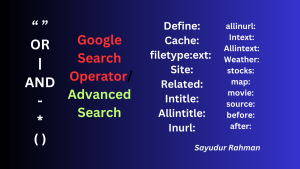Google Search Operators:
[ez-toc]
Below this article a video is attached you can watch this.
Google Search operators are powerful tools that allow users to refine and focus search results. Here’s a comprehensive guide to various Google Search operators, including the common ones and those you’ve mentioned:

-
-
Quotation Marks ” “
-
Usage: Surround a phrase with quotes to search for that exact phrase.
Example: “digital marketing strategies” returns results that contain this exact phrase.
-
-
OR Operator (OR or |)
-
Usage: Use OR between terms to find pages that include either one term or the other.
Example: branding OR marketing returns results that contain either “branding” or “marketing.”
-
-
AND Operator
-
Usage: Google automatically uses AND between words, meaning results must contain both terms.
Example: branding marketing is equivalent to branding AND marketing.
-
-
Hyphen (-)
-
Usage: Place a hyphen before a word to exclude pages containing that word.
Example: digital marketing -advertising excludes results that contain “advertising.”
-
-
Asterisk (*)
-
Usage: Use an asterisk as a wildcard to replace a word or phrase.
Example: digital * strategies might return “digital marketing strategies” or “digital media strategies.”
-
-
Parentheses (( ))
-
Usage: Group terms or operators together to control the search logic.
Example: (branding OR marketing) strategies finds pages that contain “branding strategies” or “marketing strategies.”
-
-
Define:
-
Usage: Use this operator to get a definition of a word or phrase.
Example: define:branding provides definitions for “branding.”
-
-
Cache:
-
Usage: View the cached version of a page as stored by Google.
Example: cache:example.com shows the cached version of “example.com.”
-
-
filetype
-
Usage: Find files of a specific type by specifying the extension.
Example: digital marketing filetype:pdf returns PDF documents related to digital marketing.
-
-
Site:
-
Usage: Restrict search results to a specific website.
Example: site:example.com branding returns results about “branding” from “example.com.”
-
-
Related:
-
Usage: Find sites similar to the one you specify.
Example: related:example.com returns sites similar to “example.com.”
-
-
Intitle:
-
Usage: Search for pages with a specific word in the title.
Example: intitle:branding returns pages with “branding” in the title.
-
-
Allintitle:
-
Usage: Search for pages with all the specified words in the title.
Example: allintitle:branding strategies finds pages with both “branding” and “strategies” in the title.
-
-
Inurl:
-
Usage: Search for pages with a specific word in the URL.
Example: inurl:branding returns pages with “branding” in the URL.
-
-
Allinurl:
-
Usage: Search for pages with all the specified words in the URL.
Example: allinurl:branding strategies finds pages with both “branding” and “strategies” in the URL.
-
-
Intext:
-
Usage: Search for pages containing a specific word in the body text.
Example: intext:branding finds pages where “branding” appears in the text.
-
-
Allintext:
-
Usage: Search for pages containing all the specified words in the body text.
Example: allintext:branding strategies returns pages with both “branding” and “strategies” in the text.
-
-
Weather:
-
Usage: Get the current weather for a specific location.
Example: weather:New York shows the current weather in New York.
-
-
Stocks:
-
Usage: Get information about a specific stock ticker.
Example: stocks:AAPL shows the current stock information for Apple Inc.
-
-
Map:
-
Usage: Find a map for a specific location.
Example: map:San Francisco displays a map of San Francisco.
-
-
Movie:
-
Usage: Search for information about a specific movie.
Example: movie:Inception returns information about the movie “Inception.”
-
-
Source:
-
Usage: Use this operator to specify a source in Google News.
Example: source:NYTimes searches for news from “The New York Times.”
-
-
Before: and After:
-
Usage: Find pages published before or after a certain date.
Example: marketing before:2020 returns pages about marketing published before 2020.
Example: marketing after:2020 returns pages about marketing published after 2020.
-
-
AROUND(X)
-
Usage: Find pages where two terms appear close to each other, with “X” specifying the maximum number of words between them.
Example: digital AROUND(3) marketing finds pages where “digital” and “marketing” appear within three words of each other.
-
-
Numrange (..)
-
Usage: Search within a range of numbers, often used for years, prices, or other numerical data.
Example: best laptops $500..$1000 returns results for laptops within the price range of $500 to $1000.
Example: Olympics 2000..2020 returns results about the Olympics held between 2000 and 2020.
-
-
inanchor:
-
Usage: Search for pages that contain specific words in the anchor text of backlinks.
Example: inanchor:”click here” returns pages that are linked to with the anchor text “click here.”
-
-
allinanchor:
-
Usage: Search for pages that contain all specified words in the anchor text.
Example: allinanchor:branding marketing returns pages that are linked to with anchor texts containing both “branding” and “marketing.”
-
-
Link:
-
Usage: Find pages that link to a specific URL.
Example: link:example.com shows pages that link to “example.com.”
-
-
Location:
-
Usage: Search for news or other location-specific information.
Example: festival location:Berlin returns news or events related to festivals in Berlin.
-
-
Author:
-
Usage: Find content written by a specific author, usually used in Google News.
Example: author:”John Doe” finds articles written by “John Doe.”
-
-
inbody:
-
Usage: Search for pages with specific words in the body text.
Example: inbody:”digital marketing” returns pages where “digital marketing” is mentioned in the body text.
-
-
allinbody:
-
Usage: Similar to inbody:, but for multiple words. All specified words must appear in the body text.
Example: allinbody:digital marketing strategies returns pages with all these words in the body text.
-
-
SafeSearch:
-
Usage: Use this operator to filter out explicit content from your search results.
Example: safesearch:example query will return results with explicit content filtered out.
-
-
“VERBATIM”
-
Usage: Search using Google’s “verbatim” tool, which provides results exactly matching your query without Google’s usual interpretation.
Example: _verbatim_ digital marketing strategies provides results without synonyms, similar terms, or expanded results.
-
-
intext: (variant of intext)
-
Usage: While intext: and allintext: search the body text, another variant is using intext multiple times for different words.
Example: intext:digital intext:marketing searches for pages that mention both “digital” and “marketing” anywhere in the text, regardless of order.
-
-
inposttitle:
-
Usage: Find blog posts with specific words in the post title.
Example: inposttitle:branding returns blog posts with “branding” in the title.
-
-
Daterange:
-
Usage: Search within a specific date range using Julian dates. It’s not widely used but can be handy for precise date filtering.
Example: olympics daterange:2452389-2454489 returns results for the Olympics within this Julian date range.
-
-
Around(10):
-
Usage: Similar to AROUND(X), but specifically limits to a proximity of 10 words.
Example: branding AROUND(10) strategy finds results where “branding” and “strategy” are within 10 words of each other.
-
-
Phonebook:
-
Usage: Find phonebook listings for a person or business (Note: This is no longer widely supported).
Example: phonebook:John Doe New York returns phonebook listings for John Doe in New York.
-
-
Blogurl:
-
Usage: Search for blogs that contain a specific URL (mainly used in Google Blog Search).
Example: blogurl:example.com returns blogs that link to “example.com.”
-
-
Source:
-
Usage: When using Google News, you can specify a source.
Example: climate change source:BBC returns news about climate change from BBC.
-
-
Hashtag (#)
-
Usage: Search for content using specific hashtags (often works better on social media-related searches).
Example: #digitalmarketing returns content that includes the hashtag “#digitalmarketing.”
-
-
Around(N)
-
Usage: Limits the proximity of two search terms.
Example: digital AROUND(5) marketing will find results where “digital” and “marketing” appear within five words of each other.
-
-
Inmeta:
-
Usage: Search within a specific meta tag or custom meta field on a website.
Example: inmeta:author=”John Doe” searches for content by “John Doe” in a specific meta field.
-
-
Inpub:
-
Usage: Specifically useful in Google Scholar, it searches for publications from a certain source or publisher.
Example: inpub:IEEE returns scholarly articles published by IEEE.









